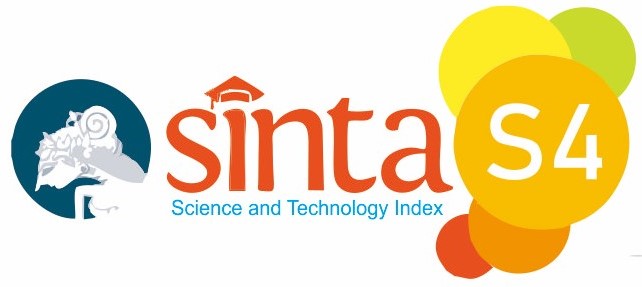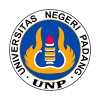Design And Efficiency Of Heat Exchanger Simulation Equipment Using Water Cooling System
Abstract
The water cooling system is a technology commonly used in various industrial and automotive applications to control the temperature of engines and equipment. The heat exchanger, as a key component in this system, plays an important role in efficiently transferring heat from one medium to another. This study aims to design and construct a cross-flow heat exchanger simulation tool that uses a water cooling system, as well as to measure its heat transfer efficiency. The method employed is experimental, involving the measurement of inlet and outlet temperatures of air and water fluids, along with the ambient temperature surrounding the tool. The analysis considers three variations of air velocity: 40 m/s, 50 m/s, and 60 m/s, as well as two different climate conditions, to gain a comprehensive understanding of the tool's performance under varying situations. The research results indicate that this simulation tool is highly effective, as the resulting temperatures align with expectations, thereby enhancing the accuracy of heat transfer analysis. These findings not only benefit mechanical engineering students studying cross-flow heat exchangers as a practical study but also contribute to further developments in the field of heat transfer. This research is expected to serve as a foundation for future studies in the design and optimization of cooling systems and the improvement of efficiency in various industrial applications
References
Almeshaal, M. A., and Choubani, K. (2023). Using the Log Mean Temperature Difference (LMTD) and ε-NTU Methods to Analyze Heat and Mass Transfer in Direct Contact Membrane Distillation. Membranes (Basel), 13(6).
Dittus, F. W., Boelter, L. M. K., and 12, V. ]. (n.d.). =Ratio of outer tube surface (air) to surface of tube at mean diameter per unit length of tube R’ =Ratio of inner tube surf:~ce (water) to surface of tube at mean diameter per u~,it length of tube 2D D+d 2d D+d D =Outside diameter of tube (inches) d =Inside diameter of tube (inches).
Ettefaghi, E. o. llah, Rashidi, A., Ghobadian, B., Najafi, G., Khoshtaghaza, M. H., Sidik, N. A. C., Yadegari, A., and Xian, H. W. (2018). Experimental investigation of conduction and convection heat transfer properties of a novel nanofluid based on carbon quantum dots. International Communications in Heat and Mass Transfer, 90, 85–92.
Hebernando, O., and Tahad, S. A. (2017). Chandra Wicaksono Eky Wijanarko.
Jeter, S. M. (n.d.). 2006 ASEE Southeast Section Conference Effectiveness and LMTD Correction Factor of the Cross Flow Exchanger: a Simplified and Unified Treatment.
Li, H., Huang, H., Xu, G., Wen, J., Wu, H., and Huang, H. (2017). Performance analysis of a novel compact air-air heat exchanger for aircraft gas turbine engine using LMTD method. Appl Therm Eng, 116, 445–455.
Naiman Ibrahim, I., Sazali, N., Shahir Jamaludin, A., Ramasamy, D., Soffie, S. M., and Hafiz Dzarfan Othman, M. (2019). A Review on Vehicle Radiator Using Various Coolants. Journal of Advanced Research in Fluid Mechanics and Thermal Sciences Journal homepage, 59, 330–337.
Pandey, A., and Dubey, K. K. (2021). Heat Transfer Analysis of Recuperator for Waste Heat Recovery Purpose Using LMTD & NTU Method. IOP Conf Ser Mater Sci Eng, 1149(1), 012022.
Peyghambarzadeh, S. M., Hashemabadi, S. H., Jamnani, M. S., and Hoseini, S. M. (2011). Improving the cooling performance of automobile radiator with Al 2O3/water nanofluid. Appl Therm Eng, 31(10), 1833–1838.
Mangrulkar, C. K., Dhoble, A. S., Chamoli, S., Gupta, A., & Gawande, V. B. (2019). Recent advancement in heat transfer and fluid flow characteristics in cross flow heat exchangers. Renewable and Sustainable Energy Reviews, 113, 109220.
Elmquist, R. E., & Hartland, A. (2016). Reference Module in Materials Science and Materials Engineering MATS 01908.
Ricki Murti, M. (2008). Laju pembuangan panas pada radiator dengan fluida campuran 80% air dan 20% RC pada rpm konstan. Jurnal Ilmiah Teknik Mesin CAKRAM.
Saputra, E., Effendy, M., Surono, A., Prasetya, A., Program, ), Teknik, S., Universitas, M., Surakarta, M., Tromol, J., Yani, A., and Kartasura, S. (n.d.). KINERJA RADIATOR KENDARAAN PADA BERBAGAI LAJU ALIRAN UDARA PERFORMANCE OF RADIATOR VEHICLE ON A WIDE RANGE OF AIR FLOW RATE.
Yadav, M. S., Giri, S. A., & Momale, V. C. (2017). Sizing analysis of louvered fin flat tube compact heat exchanger by genetic algorithm. Applied Thermal Engineering, 125, 1426-1436.
Thombare, D. (n.d.). An Overview of Radiator Performance Evaluation and Testing.
Zeeshan, M., Nath, S., and Bhanja, D. (2017). Numerical study to predict optimal configuration of fin and tube compact heat exchanger with various tube shapes and spatial arrangements. Energy Convers Manag, 148, 737–752.
Submitted
Copyright (c) 2025 Jurnal Vokasi Mekanika

This work is licensed under a Creative Commons Attribution 4.0 International License.








.svg_.png)


